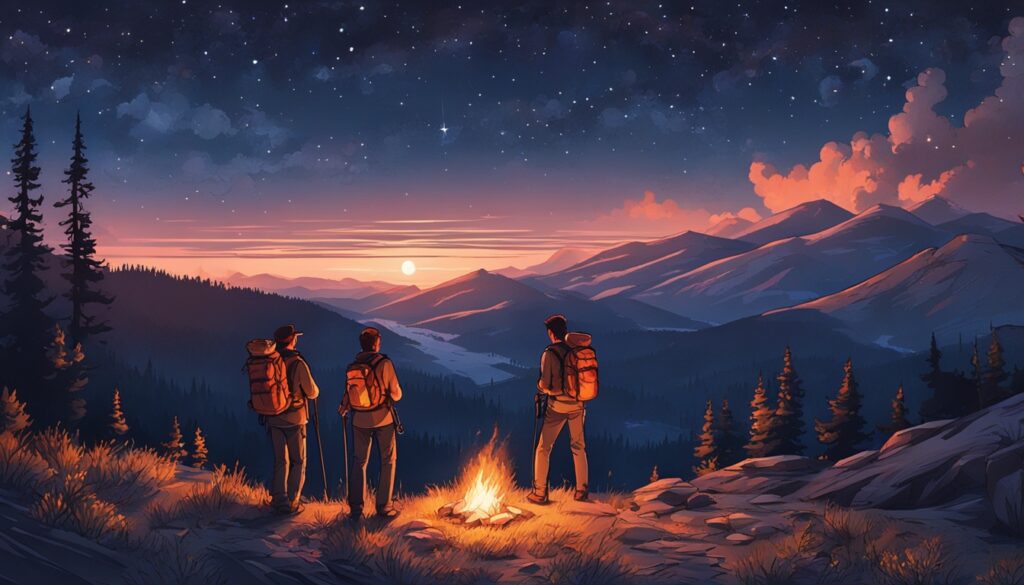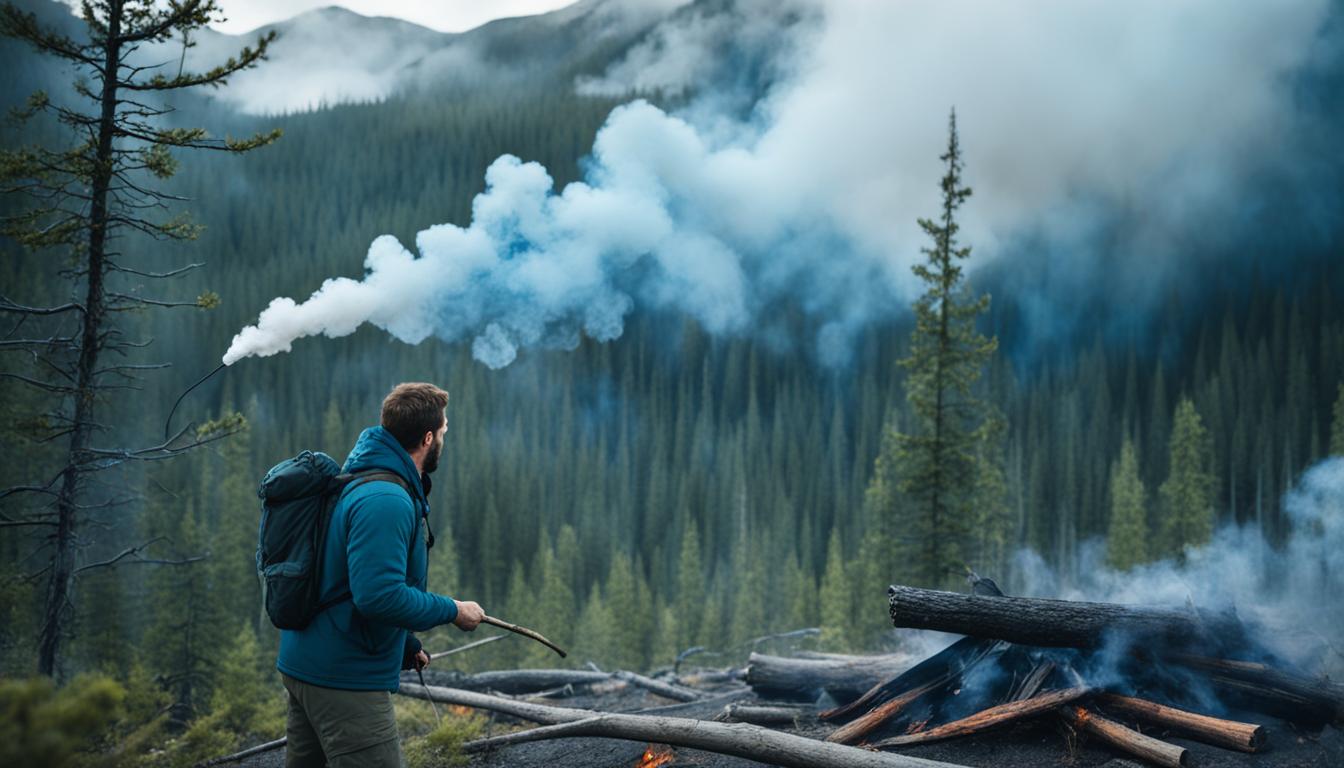When you go into the wild, knowing how to signal for help is key. Smoke signals are a trusted way to get noticed and call for help in the wilderness. This guide will teach you how to use smoke signals to stay safe and communicate outside.
Key Takeaways
- Understand the importance of distress signals and rescue signaling in the wilderness
- Learn how to choose the optimal location and conditions for smoke signals
- Discover the best materials and methods for building an effective smoke signal fire
- Explore other signaling techniques, such as light signals and audible alerts
- Enhance your wilderness survival skills and preparedness for outdoor emergencies
The Importance of Distress Signals in the Wilderness
Going into the wild, it’s key to send out distress signals to stay safe. These signals are like a beacon for help. They help you get rescued fast when you’re in trouble.
Understanding Distress Awareness and Rescue Signals
Knowing when to use signals is crucial. Signals like flares or mirrors help get attention. They make sure people know you need help.
Communication Strategies for Effective Signaling
There are many ways to signal for help in the wild. Using safety signals and alerts is important. Learning how to signal can really help you get noticed and get the help you need.
“Effective emergency communication is crucial for survival techniques in the wilderness.”
Distress signals are very important for getting help in emergencies. Learning these skills can really help you get help fast when you’re lost or in danger.
Choosing the Optimal Location for Smoke Signals
When using smoke signals in the wilderness, picking the right spot is key. You need to think about safety and how well your signal can be seen. This helps you send out a clear message for help.
Safety Considerations and Signal Visibility
First, choose a spot away from dry plants and flammable stuff. This keeps your signal fire from starting a bigger fire. It also keeps you and your rescuers safe.
Then, think about how well your signal can be seen. Pick a place where your smoke can be seen from far away. Hills or high spots are best because they make your signal easy to see from the air or ground.
Weather Conditions and Signal Longevity
Weather affects how long and well your smoke signal can be seen. Watch the wind and if it might rain. Move your signal fire to a spot that will keep burning well, making a big cloud of smoke.
| Weather Condition | Impact on Smoke Signal |
|---|---|
| High Winds | Reduces signal visibility and duration |
| Rain or Precipitation | Dampens fuel and reduces smoke production |
| Calm Conditions | Allows for a steady, long-lasting signal |
Think about safety, visibility, and weather to make your smoke signal work best. This way, you can get help in the wilderness.
Building a Smoke Signal Fire
When you’re in the wild and need help, making a smoke signal fire is key. You want it to be big and easy to see from far away. This way, people can find you quickly.
Preparing the Fire for Maximum Visibility
First, pick a spot that’s open and easy to see from afar for your smoke signal fire. Then, gather dry stuff like pine needles, twigs, and branches for the fire. Make sure the fuel is arranged so air can flow well, making lots of white smoke.
Using things that reflect light, like aluminum foil or emergency blankets, can make your signal even better.
Maintaining the Signal Fire
- Watch the fire maintenance closely to keep it safe and visible for a long time.
- Add more fuel when you need to keep the smoke and flames going.
- Change the airflow to make sure the fire is seen well.
- Put out the fire completely when you’re safe or if it’s not safe anymore.
Having a good smoke signal fire means help can come faster. It shows how important it is to know how to prepare and keep a fire in an emergency.
“The ability to create a visible, sustained smoke signal can be the difference between life and death in a wilderness emergency.”
| Material | Purpose | Benefits |
|---|---|---|
| Pine needles, twigs, and branches | Fire preparation and fuel | Dry, resinous materials that produce thick, white smoke |
| Aluminum foil or emergency blankets | Enhancing fire visibility | Reflective materials that increase the signal’s visibility |
Selecting Signal Materials
When you’re in the wild, the right signals can save your life. It’s key to pick the best emergency tools for your outdoor trips. These tools make your distress signals more visible and effective.
A brightly colored signal flag is a must-have. It’s easy for search teams to see, leading them straight to you. A compact mirror is also great. It reflects sunlight to flash signals and get attention.
- Brightly colored signal flag
- Compact signaling mirror
- Whistle for auditory cues
- Bright, high-visibility clothing
- Signal horn for loud, attention-grabbing sounds
Don’t forget a whistle in your survival kit. Its loud sound can help rescuers find you. Wearing bright clothes also makes you more visible, raising your chances of being seen.
A signal horn is also a smart choice. It makes very loud sounds that can be heard far away. This can get the attention of planes or search teams on the ground.
Choosing these survival signaling materials, emergency signaling tools, and wilderness distress signals turns your campfire into a beacon. It helps guide rescuers to you.

Creating Smoke Signals
In the wild, making smoke signals can save your life. They tell people where you are and that you need help. To make sure your smoke signals work, you need to know the right ways and stuff to use.
Materials for Thick, White Smoke
For smoke signals, you want thick, white smoke that’s easy to see. Use things that make lots of dense smoke. Good choices are:
- Damp leaves or green vegetation: These make smoke that’s thick and white because they’re wet.
- Rubber or synthetic materials: Things like tires, plastic, or rubber boots make a lot of white smoke when they burn.
- Dried animal dung: This stuff also makes a lot of thick smoke when it’s added to the fire.
Controlling Airflow and Smoke Production
It’s important to control the air going to your fire for smoke signals. This helps the fire burn right and make smoke that’s easy to see. Here’s how to do it:
- Build a fire pit with a small opening to limit the air.
- Use a chimney or structure to direct the smoke.
- Change the fire’s size and where it sits to control the air it gets.
Learning how to make smoke signals can really help you get found in an emergency. Using wilderness smoke signals is a key way to communicate when time is short.
Utilizing Light Signals
In the wilderness, light signals are a good way to call for help. They include things like signal flags, flashlights, mirrors, and beacons. These signals can help you get noticed if you’re in trouble.
Waving a brightly colored cloth or a reflective piece is a common way to signal for help. Flashlights can also be used to send Morse code or flash patterns to attract search parties.
Using a mirror to reflect sunlight is another good signal. This makes a bright light that can be seen far away. It’s useful when you don’t have other materials.
Signal fires and emergency beacons are also important for survival. Signal fires make thick smoke that’s easy to see from the air. Emergency beacons send your location to rescue teams quickly.
Learning how to use these light signals is key for outdoor adventures. Knowing what each method does can help you in emergencies. It can make you more likely to get found and rescued fast.

“In an emergency, the ability to signal for help can mean the difference between life and death. Mastering light-based signaling techniques is a crucial skill for any wilderness adventurer.”
Wilderness Signaling with Smoke
In the wild, smoke signaling is key for survival. It helps you send out a distress signal and make your location clear. Knowing how to signal with smoke is very important.
Understanding Signal Patterns and Codes
Signal patterns help show you need help. By using certain sequences and intensities, you make signals easy to spot. Learning signal codes like the SOS pattern (three short, three long, three short) boosts your rescue chances.
Enhancing Signal Visibility and Creativity
Creative smoke signals can really help in the wild. Try different materials and methods to make white smoke signals. Things like wind direction and how long you signal affect how well they’re seen.
Adding unique patterns to your smoke signals can grab rescuers’ attention. Using a special rhythm or making shapes with the smoke can be lifesaving.
Learning about signal patterns, codes, and making your signals visible can really help in an emergency. Smoke signals can be the key to a successful rescue.
Signaling With Sounds
In the wilderness, silence can be very loud. Using sound can be key to survival. Sounds can be distress signals, alerting others to your need for help. These sounds can be a lifeline, reaching far and wide.
Distinct and Recognizable Noises
Choosing sounds that are easy to recognize is important. Some top choices include:
- Siren-like wails or calls
- Powerful whistle blasts
- Vocal alerts such as shouts or yells
- Acoustic alarms or electronic distress signals
- Clanging metal objects or other loud, percussive sounds
Audible Alerts for Emergencies
Sound signaling can save lives in emergencies. Audible alerts can go beyond what you can see or hear. Using a whistle, a signal mirror, or your voice can help others find you.
| Signaling Method | Advantages | Limitations |
|---|---|---|
| Siren Calls | Highly distinctive, can carry long distances | Requires specialized equipment |
| Distress Whistles | Portable, easy to use, create loud, piercing sounds | Susceptible to wind and weather conditions |
| Vocal Alerts | Always available, can be sustained for long periods | Limited range, impacted by fatigue and vocal strain |
Learning to use sound signaling can really help you in the wilderness. It’s key for survival communication and emergency signaling.
Signaling in Daylight
In the great outdoors, knowing how to signal for help is key to getting rescued. When you’re in an emergency while hiking, using signals can really help. It can make you more visible to search teams.
Using signal flags is a great way to get noticed. These flags are bright and catch the eye easily. Another good method is the mirror signal. It uses the sun’s reflection to flash a signal far away.
- Whistles are also great for signaling in daylight. They make a loud sound that can carry far and alert people to your spot.
- Signal panels are bright and reflective. They help you stand out and get seen during wilderness rescue efforts.
- Flare signals can also be used to show where you are. They work best in places where there’s not much to block your view.
Learning these daylight signaling methods can really help you get found fast. It can make a big difference in surviving outside.
Conclusion
Going into the wild means you need to be ready and know how to survive. Knowing how to signal for help is key. Things like smoke signals, light signals, and sounds can save your life.
It’s important to know why you need to signal for help. Pick the right spot and use the right stuff. This way, you’ll be more likely to get help fast if you’re in trouble. Always keep safe and be ready when you go outside.
It doesn’t matter if you’re new to the outdoors or have been there many times. Learning how to signal for help is a must. It helps you deal with surprises and makes sure your outdoor trips are fun and safe.
FAQ
What are the essential wilderness signaling techniques using smoke?
Why is the importance of distress signals crucial in the wilderness?
What are the key considerations for choosing an optimal site for smoke signals?
How can you prepare a signal fire for effective distress communication?
What materials can enhance the visibility and effectiveness of a distress signal fire?
What techniques are important for creating effective smoke signals?
How can light signals be utilized to signal distress in survival hiking situations?
Why are signal patterns and codes important for effective distress communication?
What types of sound signals can be used for signaling in survival hiking situations?
How can visual signaling methods be utilized during daylight scenarios in survival hiking?
Source Links
- Ways to Signal for Help in the Wilderness – https://www.fieldandstream.com/survival/ways-to-signal-for-help-in-the-wilderness
- Signaling for help in the wilderness – Scouting magazine – https://scoutingmagazine.org/2019/02/signaling-for-help-in-the-wilderness/
- Using Your Survival Hiking Campfire for Distress Signals – https://blackbeardfire.com/blogs/news/using-your-survival-hiking-campfire-for-distress-signals
